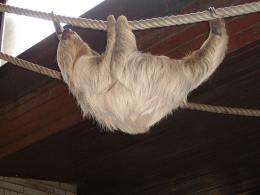September 10, 2010 report
Sloth movement secrets revealed

(PhysOrg.com) -- New studies of the movements of sloths have revealed more information about how they move around in the trees, traveling upside down.
Researchers from the Friedrich-Schiller University in Jena, Germany, used several imaging techniques to study two-toed sloths (Choloepus didactylus) and their adaptations to a life hanging upside down in the trees.
Their research generated normal video recordings, CT scans, and x-ray cinematography of the sloths' skeletons to create 3D animations showing how the animals move. No animals were sacrificed for the study, but two frozen specimens of female sloths that had died in captivity were donated for dissection from zoos in Paris, France and Dresden, Germany.
Two live sloths were trained to move along a horizontal, motorized “treadpole” 4000 mm long and 40 mm in diameter to allow x-ray videos to be recorded of their movements at a range of speeds. They were able to increase speed by increasing step length and decreasing the duration of contact and swing phases of movement.
Leader of the research, PhD candidate in evolutionary biology, John Nyakatura, said although sloths hang upside down from the branches their movements are actually surprisingly like those of animals moving right-side up, with the angles of limbs and joints being similar to those of small-medium mammals, and the same muscles being used.
The study also identified a range of special adaptations to the sloths’ unique lifestyle. For example, one of the pectoral muscles descends down to the sloth’s lower arm, whereas in other mammals it is normally attached to the upper arm near the shoulder joint. Nyakatura said this arrangement helps them to better carry their body weight and resist the force of gravity. They also have long hands and hook-like claws to enable them to cling on to branches.
The sloths’ arms are also comparatively long, but their shoulder blades are short and their chests are narrower than in other mammals of a similar size, and Nyakatura theorized that these changes maximize the mobility of the shoulders, which is needed for their arboreal existence.
Nyakatura said the studies of two-toed sloths improve our understanding of their evolution and the convergent evolution of upside-down locomotion in the two extant sloth lineages.
Sloths move extremely slowly and survive on a low-calorie diet consisting only of leaves. Living an arboreal lifestyle has dangers — falling from trees can be lethal — but it offers protection from predators and a ready supply of food.
Results of the research have been published in Zoology and online in Frontiers in Zoology.
More information:
-- Zoology (Jena). 2010 Jul 14. [Epub ahead of print] www.ncbi.nlm.nih.gov/pubmed/20637572?dopt=Abstract
-- Frontiers in Zoology 2010, 7:21, doi:10.1186/1742-9994-7-21
© 2010 PhysOrg.com

















